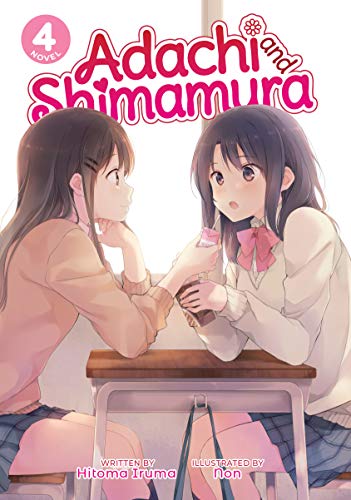By Hitoma Iruma and Non. Released in Japan by Dengeki Bunko. Released in North America by Seven Seas. Translated by Molly Lee.
Since my last review, the anime has been running, and it’s due to adapt up to this volume if it keeps at the pace it’s been using. The anime has helped me come to terms with Shimamura’s monologues somewhat – it cuts out the boring bits, which is to say 80% of them, and leaves us with what is essentially a teenage girl who is constantly doubting that she is even a functional human being. Given the evidence of this book, she is correct to worry. Not that Adachi is any better, as the start of second year shows, to her horror, that despite the “I want to be BEST friends!” of previous books, just a mere class change can mean Shimamura will be happy to drift away from her without another thought. So Adachi is ready to take the initiative. Confess? A ha ha ha no. But she’s ready to ask if they can eat lunch together, and later even ask if they can have a weekend sleepover. Baby steps, really.
As you can possibly see from the cover art, Shimamura has stopped dyeing her hair and let it settle back into her natural ‘slightly lighter than Adachi’ brown. They’re in second year now, and Hino and Nagafuji are now in another class. (Not to worry, the two get their own little subplot, though I continue to wonder whether the author is also making them a couple or just having them be goofy.) Adachi is still in her class… but is still suffering from Adachiness. As a result, when three other girls ask if Shimamura can join them for lunch, she says sure. What’s more, her old childhood friend, Tarumi, has called up again after their disastrous February date, and really, really wants to try again. They hang out. They get matching bear bookbag charms! And Tarumi, as with Adachi, runs up against the massive wall that is Shimamura’s blithe indifference to almost anything.
I mentioned the subplot with Hino and Nagafuji, and there’s one with Yashiro as well. Indeed, it has been brought to my attention that almost every single character in the book who is not a regular – a fortune teller Adachi meets who gives her courage, another seeming alien girl that Nagafuji meets at Hino’s estate – is from one of Iruma’s other books. Hell, even Yashiro straight up says here she’s not the same Yashiro as the one from Denpa Onna. This is almost entirely lost on English-speaking readers (I had to have it all explained to me), but it does show off how these books are filled with “treats for the fans”, sometimes to the detriment of the actual plot. I also left out the start of the book, which is probably the best part of it, in which we realize that something important happened much earlier than we expected. It is a sign of how much this book is obsessed with the transient nature of teenage relationships that nobody remembers this.
That said, the biggest takeaway for me from this book is: man, everyone is trying their hardest to indirectly shout “I love you!” at Shimamura, but indirectness just is not cutting it. It does make me wonder how much longer, or how many more crossover cameos, this series can do before it begins to wear on the reader. Someone needs to tear down Shimamura’s wall.
